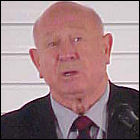 Cosmonaut Alexei Leonov, the first human being to perform extravehicular activity (or, as it has become more commonly known, a spacewalk) outside his spacecraft, dies at the age of 85. He was among the 20 Soviet Air Force pilots selected to undergo cosmonaut training in 1960, and undertook the historic first spacewalk on March 18th, 1965, aboard the Voskhod 2 mission. He remained outside the vehicle for twelve minutes, but due to his spacesuit inflating with the pressure of his breathing oxygen, he had severe difficulty climbing back into the tunnel that extended from the vehicle itself for his exit, leading mission controllers in Russia to consider the possibility that he might perish without being able to climb back in. He was able to re-enter the Voskhod capsule with considerable effort, and became a favorite among Soviet-era mission planners for the honor of being the first cosmonaut to set foot on the moon, but crewed Soviet lunar missions never came to fruition as the Apollo moon shots took the lead in the space race. Leonov was later selected to lead the Soyuz 19 mission, the Soviet half of the Apollo-Soyuz Test Project, in 1975. He was also an avid artist who drew and painted many of his own space experiences, as well as those related to him by other astronauts and cosmonauts.
Cosmonaut Alexei Leonov, the first human being to perform extravehicular activity (or, as it has become more commonly known, a spacewalk) outside his spacecraft, dies at the age of 85. He was among the 20 Soviet Air Force pilots selected to undergo cosmonaut training in 1960, and undertook the historic first spacewalk on March 18th, 1965, aboard the Voskhod 2 mission. He remained outside the vehicle for twelve minutes, but due to his spacesuit inflating with the pressure of his breathing oxygen, he had severe difficulty climbing back into the tunnel that extended from the vehicle itself for his exit, leading mission controllers in Russia to consider the possibility that he might perish without being able to climb back in. He was able to re-enter the Voskhod capsule with considerable effort, and became a favorite among Soviet-era mission planners for the honor of being the first cosmonaut to set foot on the moon, but crewed Soviet lunar missions never came to fruition as the Apollo moon shots took the lead in the space race. Leonov was later selected to lead the Soyuz 19 mission, the Soviet half of the Apollo-Soyuz Test Project, in 1975. He was also an avid artist who drew and painted many of his own space experiences, as well as those related to him by other astronauts and cosmonauts.
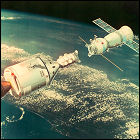 After two years of hammering out details and wording, President Nixon and Soviet Premier Alexei Kosygin sign an international agreement to share science and technology between the United States and Soviet Union, including an agreement to mount a joint space mission culminating in the docking of an Apollo spacecraft and a Soyuz spacecraft in Earth orbit in 1975. Both nations’ space agencies begin crew selection and technical preparations for a joint venture that seemed impossible during the Cold War-fueled race to the moon.
After two years of hammering out details and wording, President Nixon and Soviet Premier Alexei Kosygin sign an international agreement to share science and technology between the United States and Soviet Union, including an agreement to mount a joint space mission culminating in the docking of an Apollo spacecraft and a Soyuz spacecraft in Earth orbit in 1975. Both nations’ space agencies begin crew selection and technical preparations for a joint venture that seemed impossible during the Cold War-fueled race to the moon.
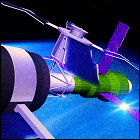 With planning already well underway for the Apollo-Soyuz mission which won’t take place until
With planning already well underway for the Apollo-Soyuz mission which won’t take place until 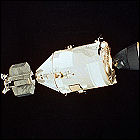 The final launch of an Apollo spacecraft takes place as the last Saturn rocket carries the American component of the Apollo-Soyuz Test Project into orbit. A cooperative international mission intended to see the Apollo capsule dock with a Soviet-launched Soyuz, the ASTP will be the last Apollo flight as the push toward the reusable Space Shuttle takes over NASA’s resources and planning. Aboard the Apollo command/service module are Commander Thomas Stafford, command module pilot Vance Brand, and docking module pilot Deke Slayton, the last of the seven original Mercury astronauts to reach space (heart conditions have prevented him from taking part in a mission until now). Soyuz 19, carrying cosmonauts Alexei Leonov and Valery Kubasov, lifts off a few hours earlier.
The final launch of an Apollo spacecraft takes place as the last Saturn rocket carries the American component of the Apollo-Soyuz Test Project into orbit. A cooperative international mission intended to see the Apollo capsule dock with a Soviet-launched Soyuz, the ASTP will be the last Apollo flight as the push toward the reusable Space Shuttle takes over NASA’s resources and planning. Aboard the Apollo command/service module are Commander Thomas Stafford, command module pilot Vance Brand, and docking module pilot Deke Slayton, the last of the seven original Mercury astronauts to reach space (heart conditions have prevented him from taking part in a mission until now). Soyuz 19, carrying cosmonauts Alexei Leonov and Valery Kubasov, lifts off a few hours earlier.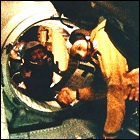 The last Apollo spacecraft to fly makes history by docking with a Soviet-launched Soyuz spacecraft in orbit, allowing the crews to visit each other and conduct joint scientific experiments. The first docking of the
The last Apollo spacecraft to fly makes history by docking with a Soviet-launched Soyuz spacecraft in orbit, allowing the crews to visit each other and conduct joint scientific experiments. The first docking of the 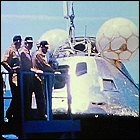 The “age of Apollo” comes to an unbreathable end in an incident during the return of the final Apollo spacecraft. Returning from their successful Apollo-Soyuz Test Project flight, astronauts Thomas Stafford, Deke Slayton and Vance Brand are exposed to fumes from their vehicle’s own reaction control thrusters, thanks to the thrusters firing after the capsule’s air vents open during descent toward the Pacific Ocean. Brand reportedly passes out momentarily due to the toxic fumes. All three astronauts are hospitalized for two weeks in Hawaii.
The “age of Apollo” comes to an unbreathable end in an incident during the return of the final Apollo spacecraft. Returning from their successful Apollo-Soyuz Test Project flight, astronauts Thomas Stafford, Deke Slayton and Vance Brand are exposed to fumes from their vehicle’s own reaction control thrusters, thanks to the thrusters firing after the capsule’s air vents open during descent toward the Pacific Ocean. Brand reportedly passes out momentarily due to the toxic fumes. All three astronauts are hospitalized for two weeks in Hawaii. Forge Books posthumously publishes astronaut Deke Slayton’s non-fictional memoir of his time in NASA, “
Forge Books posthumously publishes astronaut Deke Slayton’s non-fictional memoir of his time in NASA, “ Smithsonian Books publishes General Thomas Stafford’s non-fictional memoir of his time in NASA, “
Smithsonian Books publishes General Thomas Stafford’s non-fictional memoir of his time in NASA, “ The surviving Apollo-Soyuz Test Project astronauts and cosmonauts gather at the Stafford Air & Space Museum (founded by Apollo-Soyuz commander Thomas Stafford) in Weatherford, Oklahoma to mark the 30th anniversary of the first international manned spaceflight. (theLogBook.com’s webmaster is in attendance.)
The surviving Apollo-Soyuz Test Project astronauts and cosmonauts gather at the Stafford Air & Space Museum (founded by Apollo-Soyuz commander Thomas Stafford) in Weatherford, Oklahoma to mark the 30th anniversary of the first international manned spaceflight. (theLogBook.com’s webmaster is in attendance.) Cosmonaut Alexei Leonov, the first human being to perform extravehicular activity (or, as it has become more commonly known, a spacewalk) outside his spacecraft, dies at the age of 85. He was among the 20 Soviet Air Force pilots selected to undergo cosmonaut training in 1960, and undertook the historic first spacewalk on March 18th, 1965, aboard the
Cosmonaut Alexei Leonov, the first human being to perform extravehicular activity (or, as it has become more commonly known, a spacewalk) outside his spacecraft, dies at the age of 85. He was among the 20 Soviet Air Force pilots selected to undergo cosmonaut training in 1960, and undertook the historic first spacewalk on March 18th, 1965, aboard the